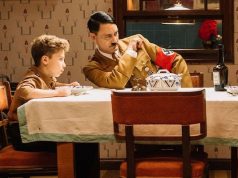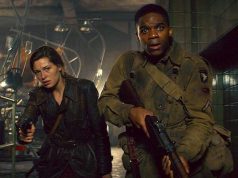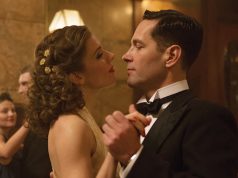It might be hard to assess the true value of Clint Eastwood’s “Flags of Our Fathers” until we see “Letters from Iwo Jima,” the companion piece that addresses the World War II battle from the Japanese perspective. The opening narration in “Flags” says we tend to want our war stories simple, with clear-cut heroes and villains, but “most of the time they are not who we think they are.” You get the impression “Letters” will flesh out that theme more than “Flags” does by itself.
“Flags of Our Fathers” stands alone fairly well, though, as a self-contained behind-the-scenes story that’s equal parts patriotism and skepticism (and don’t listen to people who tell you those things are mutually exclusive). It’s emotionally stirring in some places, eye-opening in others, and a well-told story all the way through.
The subject is the iconic photo of Marines raising the American flag on Iwo Jima — or more specifically, the aftermath of that photo. What those of us under the age of 70 may not realize is that the picture did not become iconic over time; it was touted as one for the ages less than a day after it was snapped and was an immediate sensation. And while it may seem like a modern practice, manipulation of public sentiment by the government and the media was an oft-deployed tactic in 1945, too.
There are six men in that photo, five Marines and a Navy corpsman, raising the flag on Mt. Suribachi on Feb. 23, after four days of heavy fighting. Securing the mountain was key to the Allies’ success, though it was another 31 days and thousands more casualties before the entire island was officially secure and the Japanese conclusively repelled.
Three of the six soldiers were subsequently killed in battle. The remaining three were taken out of combat and sent on a press tour, a trio of American idols who could boost homeland morale and maybe sell some war bonds while they were at it.
Based on the book by James Bradley (son of the Navy corpsman in the photo) and Ron Powers, the screenplay was adapted by Hollywood darlings William Broyles Jr. (“Jarhead,” “Cast Away”) and Paul Haggis (“Crash,” “Million Dollar Baby”). It has a modern-set framing story in which Bradley searches for details about his father’s life, and frequent lengthy flashbacks to the battle itself, but the thrust of the story is in the months after the photo was taken, in the final days of World War II.
John “Doc” Bradley (Ryan Phillippe), Rene Gagnon (Jesse Bradford) and Ira Hayes (Adam Beach) are the surviving members of the six-man flag-raising team, recruited by no less an authority than President Roosevelt to help in the upcoming war bond drive. The photo itself is a grand image for the drive, and to have three of the men depicted in it live and in person will surely get people to open their checkbooks. Some $14 billion is needed to finish the war, and at this point the U.S. government is practically bankrupt.
Bradley and Hayes are embarrassed to be making cheesy public appearances and riding on parade floats while their countrymen are still being killed overseas, but they recognize the need for money to keep those countrymen’s guns firing and planes flying. Gagnon, meanwhile, was a slacker to begin with. His laziness and ineptitude earned him secondary positions in battle — helping raise the flag was about the most dangerous thing he did on Iwo Jima — and he’s only too happy to get out of active duty altogether and soak up his 15 minutes of fame back home.
And so these three, these fellow soldiers who knew each other in battle but weren’t particularly close until now, tour the country as a team. They’re given heroes’ welcomes wherever they go. They appear at receptions and in stadiums and at statue unveilings. They make speeches urging Americans to support the war effort and to remember that “the real heroes are the ones who didn’t come back.”
But other details trouble them. All three are aware that they were participating in the SECOND flag-raising on Iwo Jima, that the first flag was taken down because the Secretary of the Navy wanted it as a souvenir. The men who raised the first flag, the one that actually meant something? Completely forgotten.
What’s more, one of the men in the famous photograph was misidentified. The real boy’s mother swears she recognizes her own son’s backside, but the official record says it’s not him. To come forward with the truth, either about the misidentified soldier or the fact that it was a second, unnecessary flag-raising, would ruin the perfectness of the iconic photo and the war bond drive it’s helping to promote. What’s more patriotic: telling the truth and damaging the P.R. effort, or shutting up and helping America win the war? If that question doesn’t resonate in 2006, I don’t know what does.
“Flags of Our Fathers” is unusual as a war film because its focus is more on the battle’s aftermath than on the fighting itself (though the combat flashbacks are graphic and gruesome enough, Eastwood having taken a few pages from co-producer Steven Spielberg’s “Saving Private Ryan” strategy book). In other ways, though, the film is representative of how war films have been in the past 30 years: less rah-rah and more questioning, less superficial and more aware of how politics, pettiness and good ol’ human nature come into play even in the midst of war. It humanizes the war, which is something a lot of older films, with their protagonists who were combination superhero and Boy Scout, often failed to do.
Doc Bradley is a calm moral center for the film, played stoically (if not memorably) by Ryan Phillippe, and providing a good-hearted balance to Jesse Bradford’s flawed, in-over-his-head Rene Gagnon.
But special praise is due to Adam Beach as Ira Hayes. Hayes is an alcoholic after the war, never able to deal with his survivor’s guilt and the half-truths surrounding the publicity tour. He’s also a Pima Indian, making him subject to humiliating jokes and patronizing remarks even as he’s being lauded as a hero. (“Did you scalp them?” asks one politician of Hayes’ success on the battlefield, thinking he’s making a perfectly respectful and good-natured joke.)
Beach had a surprisingly solid turn in the 2002 WWII drama “Windtalkers” and is impressive again here in similar territory. Where Phillippe is dutiful and rigid and Bradford is loose and charismatic, Beach is a storm of emotions. He holds it together in one scene and falls to pieces in the next, constantly fighting in his head the battle that should have ended weeks ago. Phillippe, Bradford, and the actors who play their fellow soldiers in the war scenes give the film weight and depth. Beach gives the film its heart.
B (2 hrs., 12 min.; )





